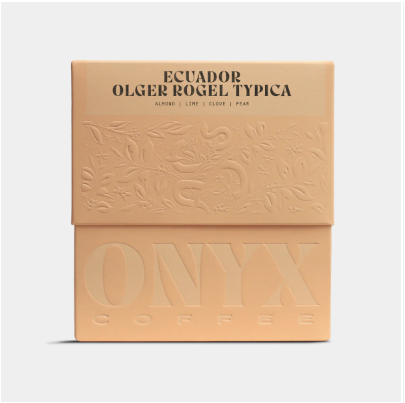
About this Coffee
Lovers of washed coffees delight, for this coffee from Olger Rogel hits all the marks of great washed coffees. This micro-lot from Loja, Ecuador highlights all the characteristics we love about the typica variety. Reminiscent of crisp yellow pear and lime in the acidity, with the balance and soft bitterness of almonds, this coffee is structured and sweet.
Over the past few years, Juan Peña has become a prominent figure in the coffee industry. Season after season, he is up for awards as a notable coffee producer, and his coffee has been on the national and world stage in the hands of competitors. It would be easy to believe that Juan has been growing coffee for many decades, but Juan began growing coffee just eleven years ago. Juan’s farm, Hacienda a Papaya, chose to diversify their crop after a disastrous rose harvest, and choosing to experiment with coffee took them down the path to become a prominent producer of Ecuadorian coffee. His rise to prominence has been multifaceted, although it’s mostly due to his scientific approach to growing and processing his coffees. Each step of harvest is well documented and adjusted from season to season. Over each season, Juan has extended his work not only to his own farm, but also to develop projects on neighboring farms. This washed typica is grown by Olger Rogel in the south.
In 1996, Olger Rogel and his wife, Magda Zabala, made a decision to leave their hometown in Ecuador’s Loja province and relocate to Nanegal in search of better job opportunities. At that time, the northwest corner of Pichincha, where they settled, was sparsely populated, and many rural residents were moving to Quito, Ecuador’s capital, in pursuit of work in the urban areas.
Determined to forge their path, Olger and Magda became pioneers in the region by planting coffee on their land in 2007. Over the course of 15 years, their dedication and hard work have transformed their venture into a thriving coffee farm, now spanning 10 acres of land adorned with 9,000 coffee trees. The family business has grown to encompass four children who actively contribute to its success.
Today, the farm employs 2-3 full-time workers and relies on a harvest staff of 60 individuals. Olger, alongside one of his daughters, diligently tends to the coffee plants, ensuring their growth and well-being. Meanwhile, Magda takes charge of roasting the coffee, a crucial step in the family’s coffee shop operation, where their other daughter actively lends a hand. Additionally, the family packages the coffee for domestic sales, and this task is efficiently supported by their two sons. Through hard work, determination, and a shared passion for coffee cultivation, Olger and Magda have built a remarkable legacy in Nanegal. Their journey from newcomers to successful coffee producers stands as a testament to the power of perseverance and the value of family unity.
WASHED PROCESSED COFFEES
The washed process begins with coffee cherries delivered to the washing station, both from the primary market or from farmers bringing their coffee directly to the mill. The cherries are inspected, and an initial quick round of hand-sorting separates the defective coffees before placing them into the hopper. They are then funneled to the depulper, which removes the fruit from the seeds (beans). After that phase is done, the coffee is fermented underwater for approximately 12-36 hours. During this fermentation, a microbial de-mucilagation takes place, which allows the outer fruit and pectin layer to break down, making the coffee easier to dry. This phase also crucially alters the organic acids within the coffee, as sugars and organic acids are transformed, with the best washed coffees maintaining their complex fruit esters. Once the fermentation is complete, the parchment is emptied into the washing channels, where it is agitated with rakes to remove the last of the fruit layer. During this step, the water is refreshed to ensure its capability of separating the fruit layer from the seed. Once the washing is complete, the coffee is taken to the raised drying tables for sun drying.